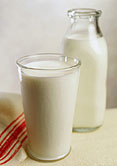
MONDAY, March 18 (HealthDay News) — Drinking low-fat or skim milk does not prevent toddlers from gaining excess weight and is actually associated with overweight and obesity in preschool children, a new study finds.
The findings challenge a recommendation from the American Academy of Pediatrics (AAP) and the American Heart Association (AHA) that all children drink low-fat or skimmed milk after age 2 to reduce their saturated fat intake and avoid excess weight gain.
One expert not connected to the study said it brings up interesting questions.
“For many years the message to parents has been simple: after about 2 years of age it is recommended to change your child’s milk consumption to low-fat or skim milk,” said Marlo Mittler, a registered dietitian at Cohen Children’s Medical Center of New York in New Hyde Park. “This latest study says we need to think this through.”
In the study, researchers gathered data about the milk consumption of 11,000 American children when they were 2 and 4 years old. They were also weighed at both ages.
The number of children who were overweight/obese was 30 percent at age 2 and 32 percent at age 4. Overweight/obese children were more likely to drink skimmed/semi-skimmed milk at age 2 (14 percent) and age 4 (16 percent) than normal weight children (9 percent at age 2 and 13 percent at age 4).
The average weight of children who drank 2 percent/full-fat milk was also lower than that of children who drank skimmed/semi-skimmed milk, even after the researchers accounted for other factors, according to the study published online March 18 in the journal Archives of Disease in Childhood.
When they analyzed weight gain trends over time, the researchers found no overall differences between children who drank skimmed/semi-skimmed milk and those who drank 2 percent/full-fat milk.
However, children who regularly drank skimmed/semi-skimmed milk and were not overweight/obese at age 2 were 57 percent more likely to become so by age 4, the investigators noted.
Logic would suggest that giving children low-fat milk would help protect them from putting on excess pounds, but the reality is more complex, explained the research team led by Mark Daniel DeBoer, an associate professor in the pediatric endocrinology division at the University of Virginia School of Medicine.
They suggested that milk fat may increase the feeling of fullness and reduce a child’s appetite for other fatty or calorie-dense foods.
Mittler agreed that the theory might have merit. “Many questions come up about how much [the children] drink as well as the amount of consumption in general,” she said.
“So while the AAP and AHA can stand behind their recommendation, more needs to be considered when thinking of your child’s overall diet,” Mittler said. “Changing to skimmed or low-fat milk may not be the only answer to avoiding obesity.”
According to the study authors, rather than giving children low-fat milk, parents might be better off using proven weight control measures, such as increasing children’s physical activity levels and consumption of fruits and vegetables, restricting their intake of sugary drinks, and limiting the amount of time they spend in front of the television and computer, the researchers suggested in a journal news release.
But one other expert stands by the AAP/AHA recommendations to give kids low-fat or skimmed milk after age 2.
“The children in the study would have had a greater percentage of obesity if they had been on whole milk,” said Dr. Peter Richel, chief of pediatrics at Northern Westchester Hospital in Mt. Kisco, N.Y. “The degree of obesity cited in the study is probably due to our Western cultural habits of unnecessarily larger portions and sugar consumption,” he believes. “The children of America have far too much juice and soda, which are loaded with excess calories.”
Although the study found an association between consumption of skimmed/semi-skimmed milk and extra weight in preschool children, it could not prove a cause-and-effect relationship.
More information
The Nemours Foundation has more about your child’s weight.

